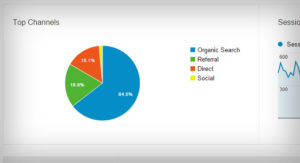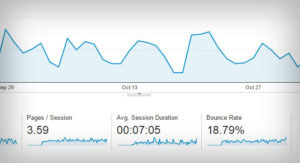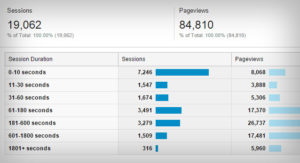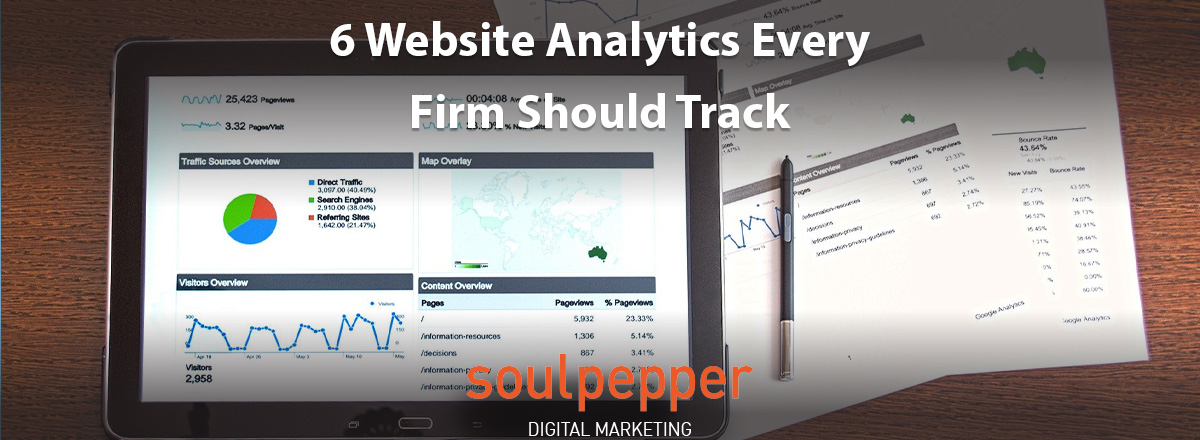Data and analytics must be the foundation of your website’s success!
Aesthetics aside, truly knowing how your website functions and is contributing to your firm’s goals really should be a marketing priority. Doing a regular deep dive into your Google Analytics account to measure your digital marketing success should be second nature to you by now, no? If not, we’re going to take you through some of the key metrics your firm can and should be measuring. Let’s take a look.
1. Number Of Visitors

The main reason you have a website is to get people to visit it, right? If you answered ‘yes’ to this near rhetorical question, then we’re off to a good start!
One of the key metrics you and your team should monitor each month is the number of website visitors your site receives. Keep an eye on any spikes or sudden traffic dips so you can quickly figure out what the problem may be, and resolve it in time to meet your weekly/monthly targets.
Take a step back and increase your time range to look at the last 365 days (or more if you have the history). Look for any seasonal trends that you can combine with what you already know about your industry to get ahead of the game and make marketing decisions in advance of business trends.
2. Traffic Sources

Do you know where your visitors are actually coming from? Did they use a referral link to get your website? Or perhaps they followed a link from one of your social media pages? This information is particularly important when you’re deciding where to invest advertising dollars, and accurately measure results after campaigns end.
Using your Google Analytics’ acquisition window, detailed source and medium information is readily available for you to dissect so you can fully understand your site’s visitor trends.
3. Bounce Rate

Getting visitors to your website is only one part of the game. Getting them to stay, however, is a whole other thing! Understanding what drives your visitors to stick to just the one page, quickly exit another or sift through all your content without closing their browser window – is incredibly important. Potential underlying problems to a higher than usual bounce rate include broken links, a recent update in the backend that didn’t take or simply having content that doesn’t speak to your prospective client.
All these issues can be easily remedied once you gather and understand your traffic data (by source).
4. Average Time On Page/Engagement

Much like your bounce rate, this metric helps you further understand whether your content is appealing enough to keep your audience’s attention long enough to drive your point home and get the phone to ring.
Are your blogs sprinkled with just the right amount of relevant information? Is your services page up to date? Does it spell out everything your business has to offer? Is your video content informative and visually captivating enough to get visitors to watch until the end? Understanding where your most qualified leads are coming from and how long they stayed on a particular page will give you perspective on what content is working for you and what may need to be binned!
5. Click-Through Rate (CTR)
Calls-to-action (CTAs) are a critical aspect of every web page and should be set up as events in Google Analytics. You need to direct your visitors to the next thing you want them to do (e.g add to cart, contact us, watch now, view more). If your CTAs are not strategically dotted around your website and/or not being clicked, you need to make changes so your visitors take the next step toward becoming qualified leads or clients.
Insider tip: A/B test your CTAs (play with placement, size, design and text) to analyze what is driving users to click through. Getting the balance just right between CTAs that are too ‘spammy’, ad-like in nature or intriguing enough to increase your CTR is something you and your team may need to work on. As always though, if you need any help in this regard, give us a call for a free marketing consultation with one of our trusted digital strategists. See what we did there?
6. Conversion Rate

Whether you run a really small or large firm, this metric may be one you’re familiar with and already track. Converting visitors-to-leads-to-customers to grow your bottom line is one of the main reasons you’re in business. With this in mind, being cognizant of the conversion rates that apply to your line of work should be tracked on a monthly basis. At least. These metrics could include:
- landing page conversion rate,
- email conversion rate,
- visitor-to-lead conversion rate,
- lead-to-customer conversion rate and so on.
The bottom line is that each of these data points will contribute to your site working to gain a customer and revenue for your business.
Need another quick digital marketing refresher course, check this out. We have a tonne of resources curated just for you, to help take your business to new heights.
-Team Soulpepper

